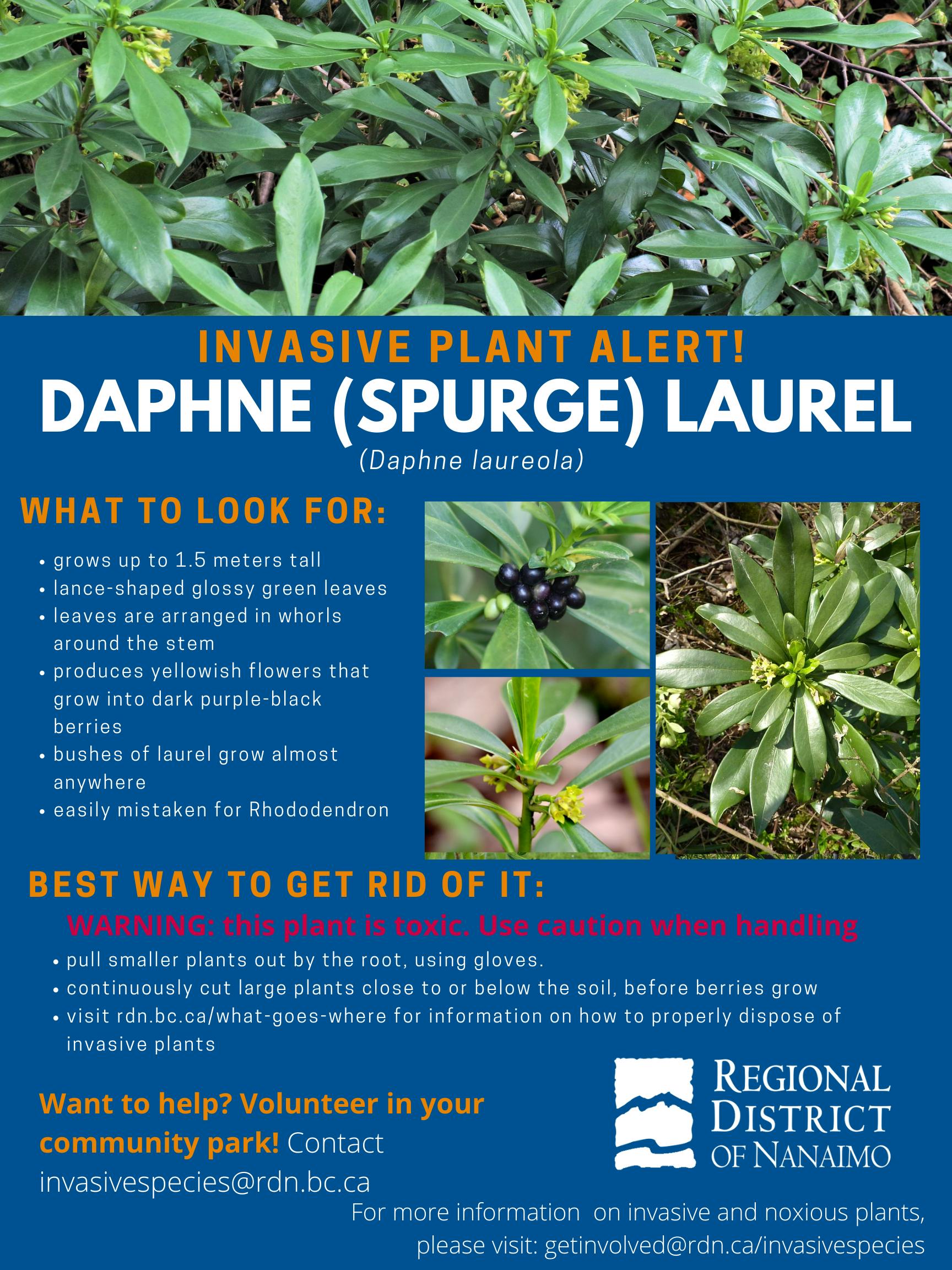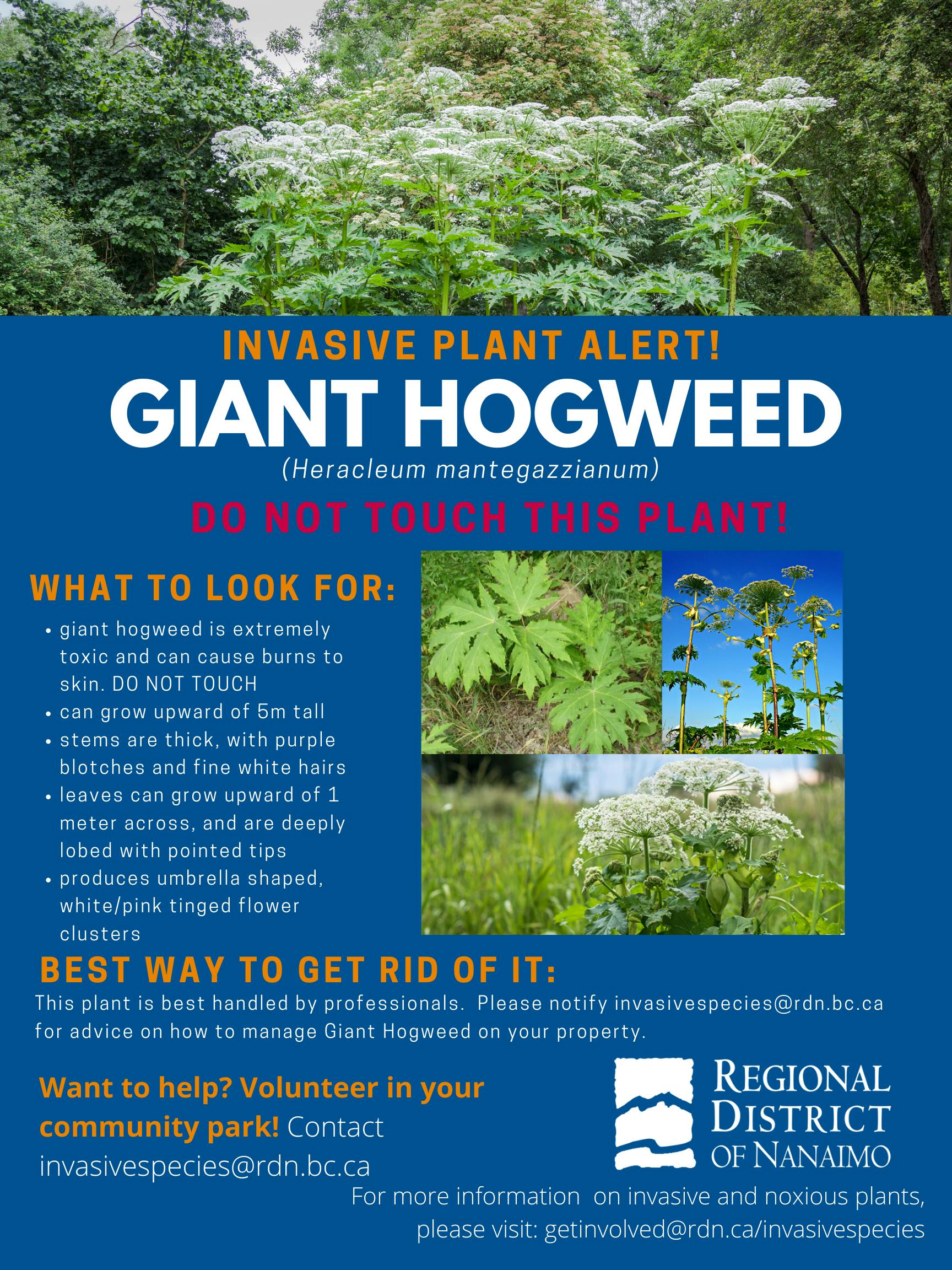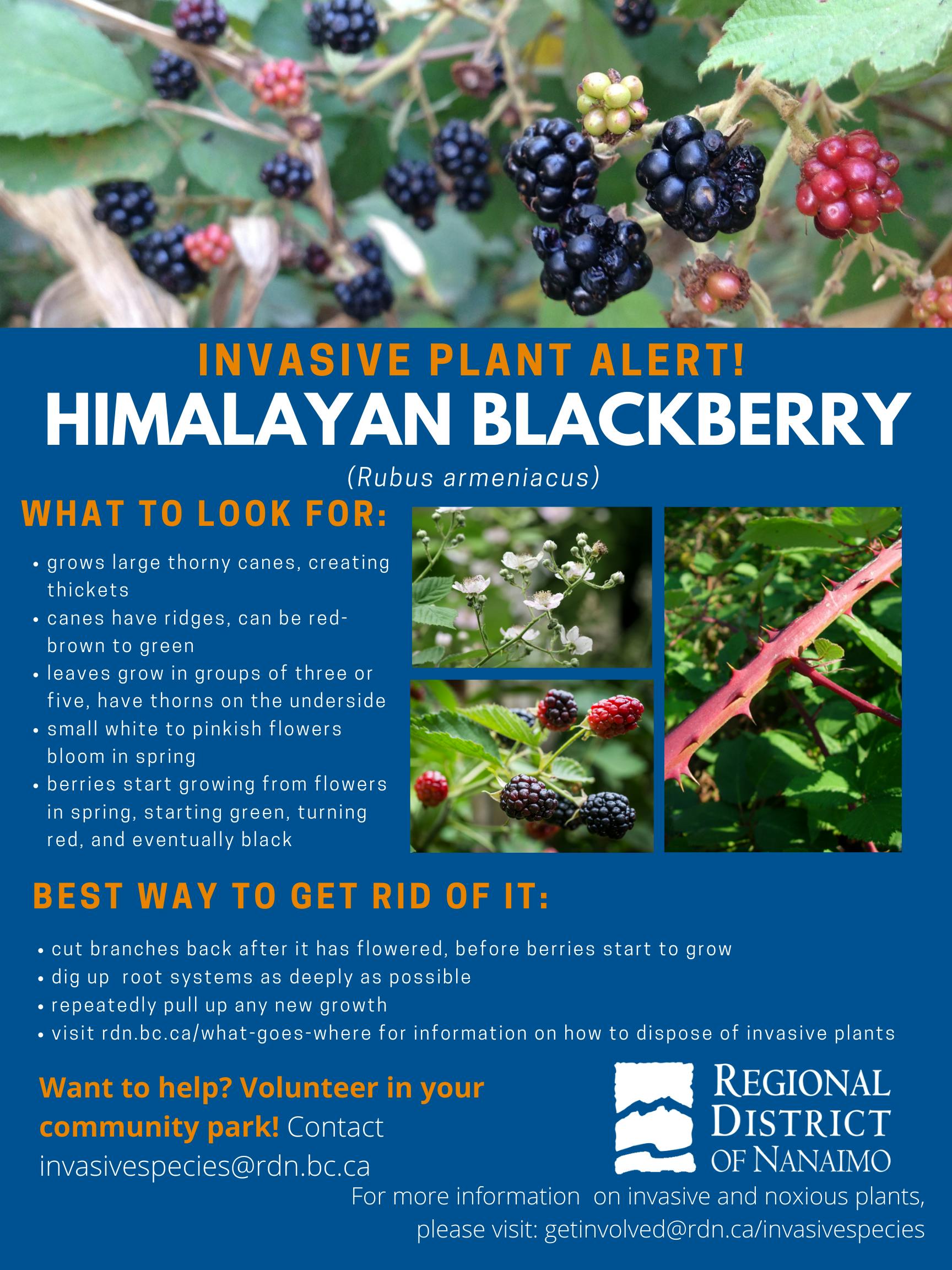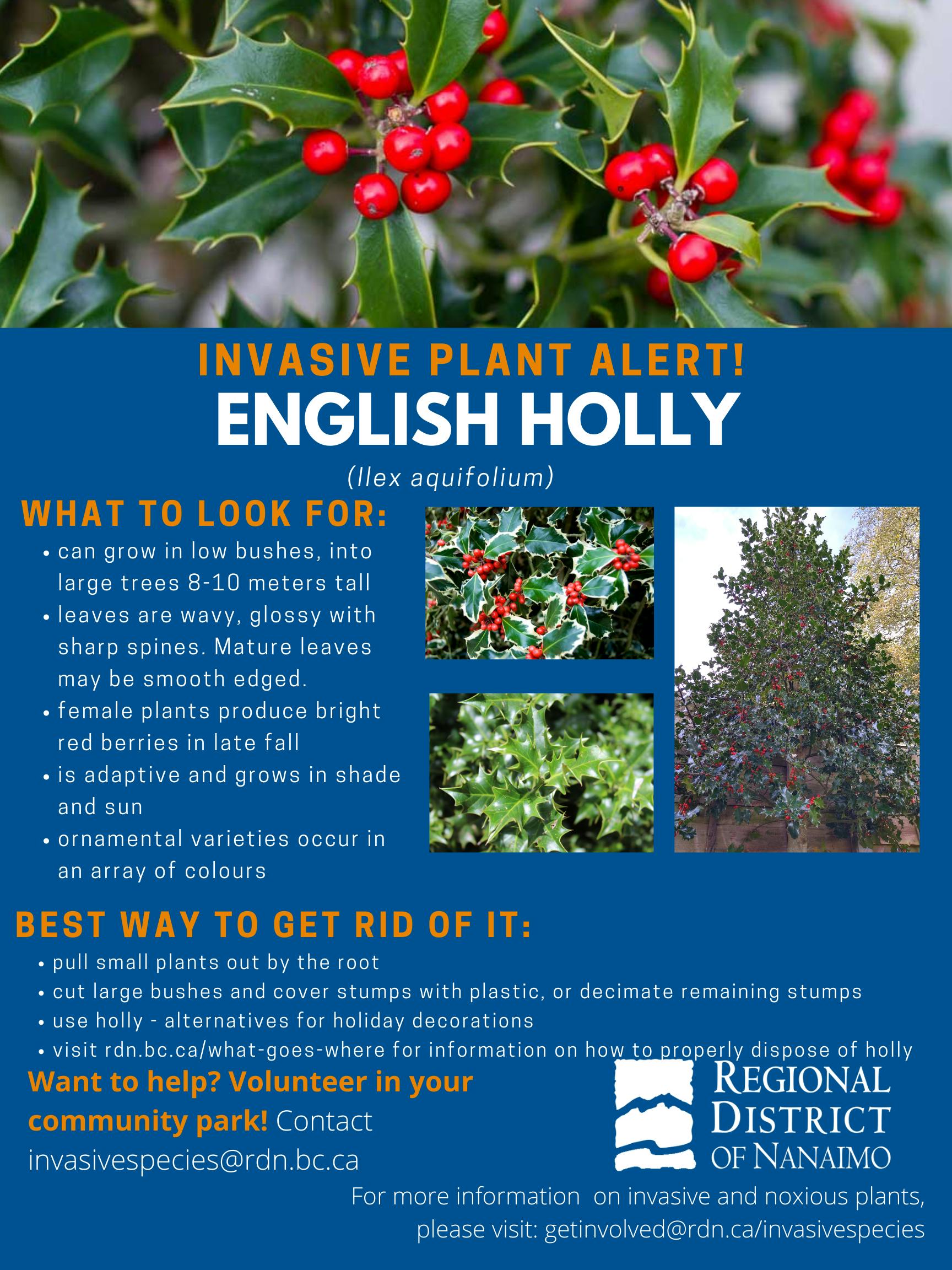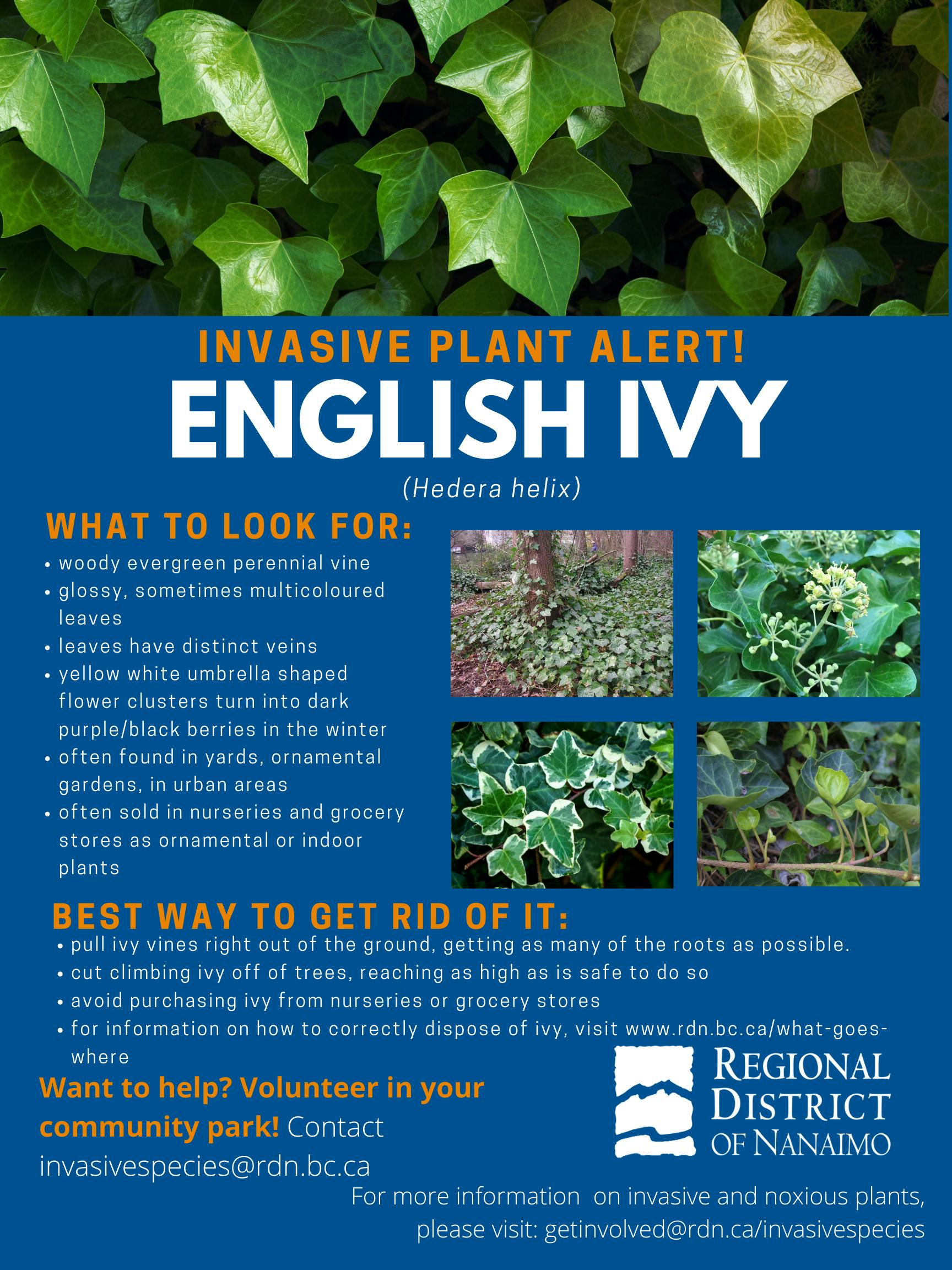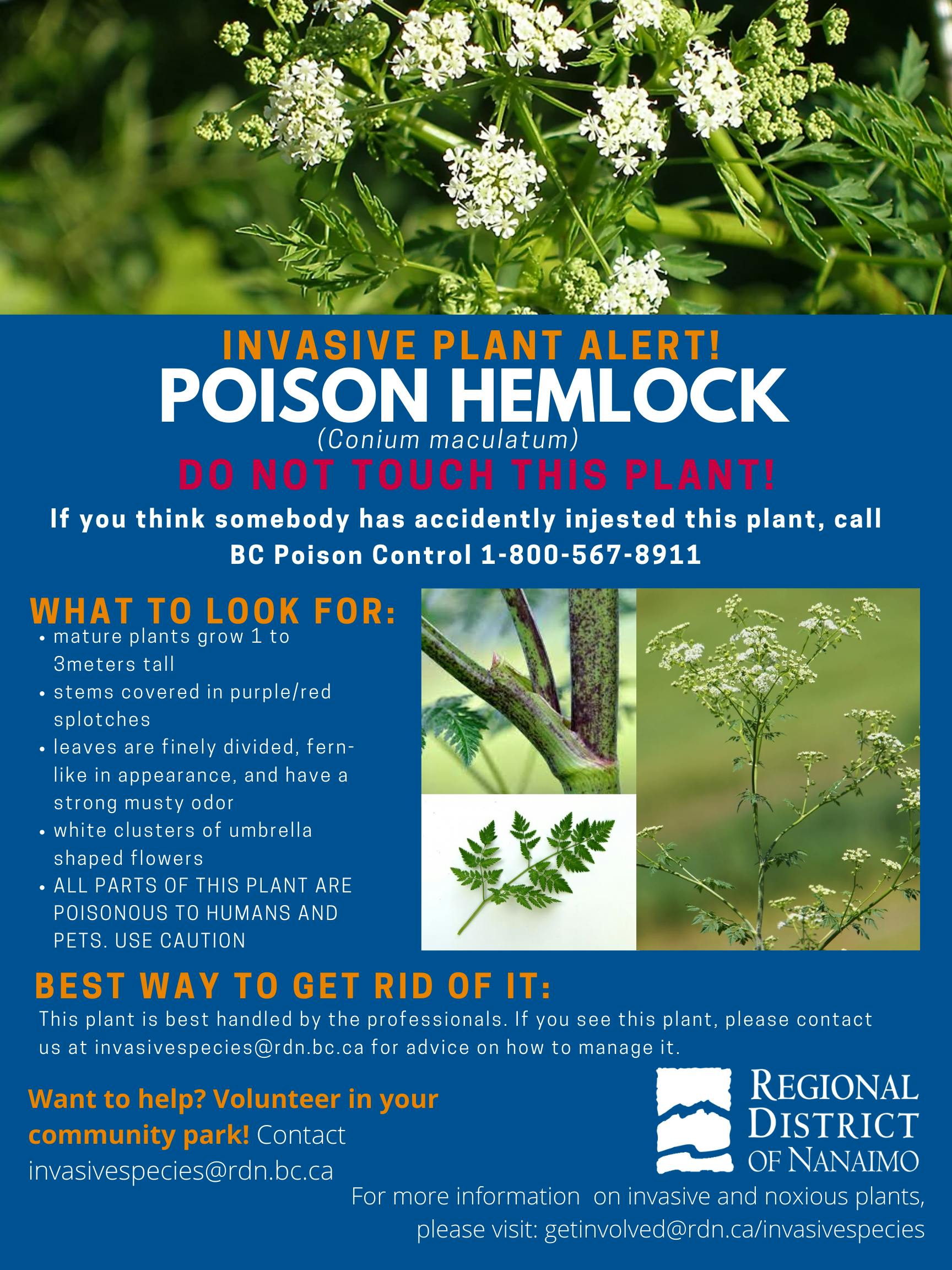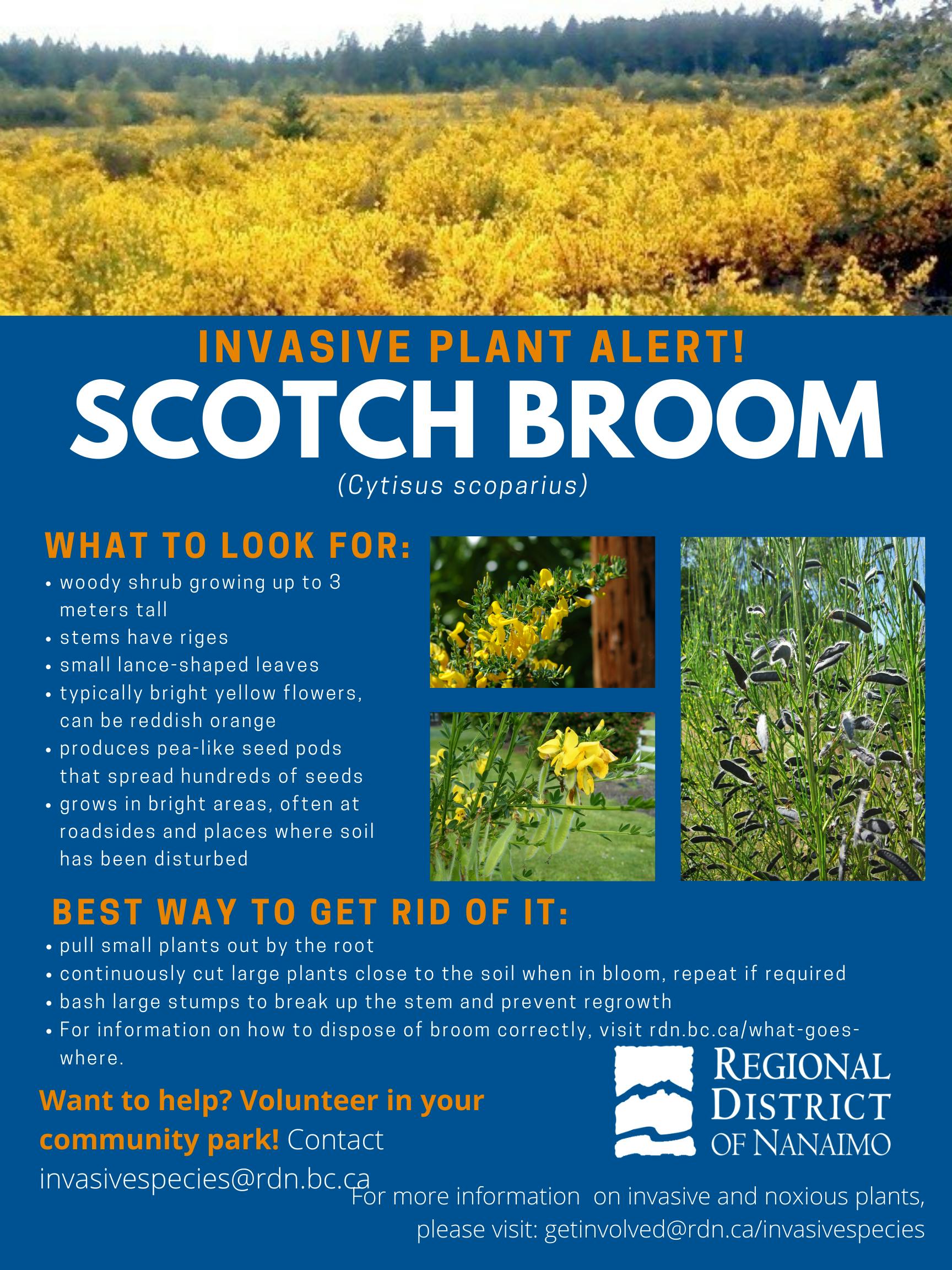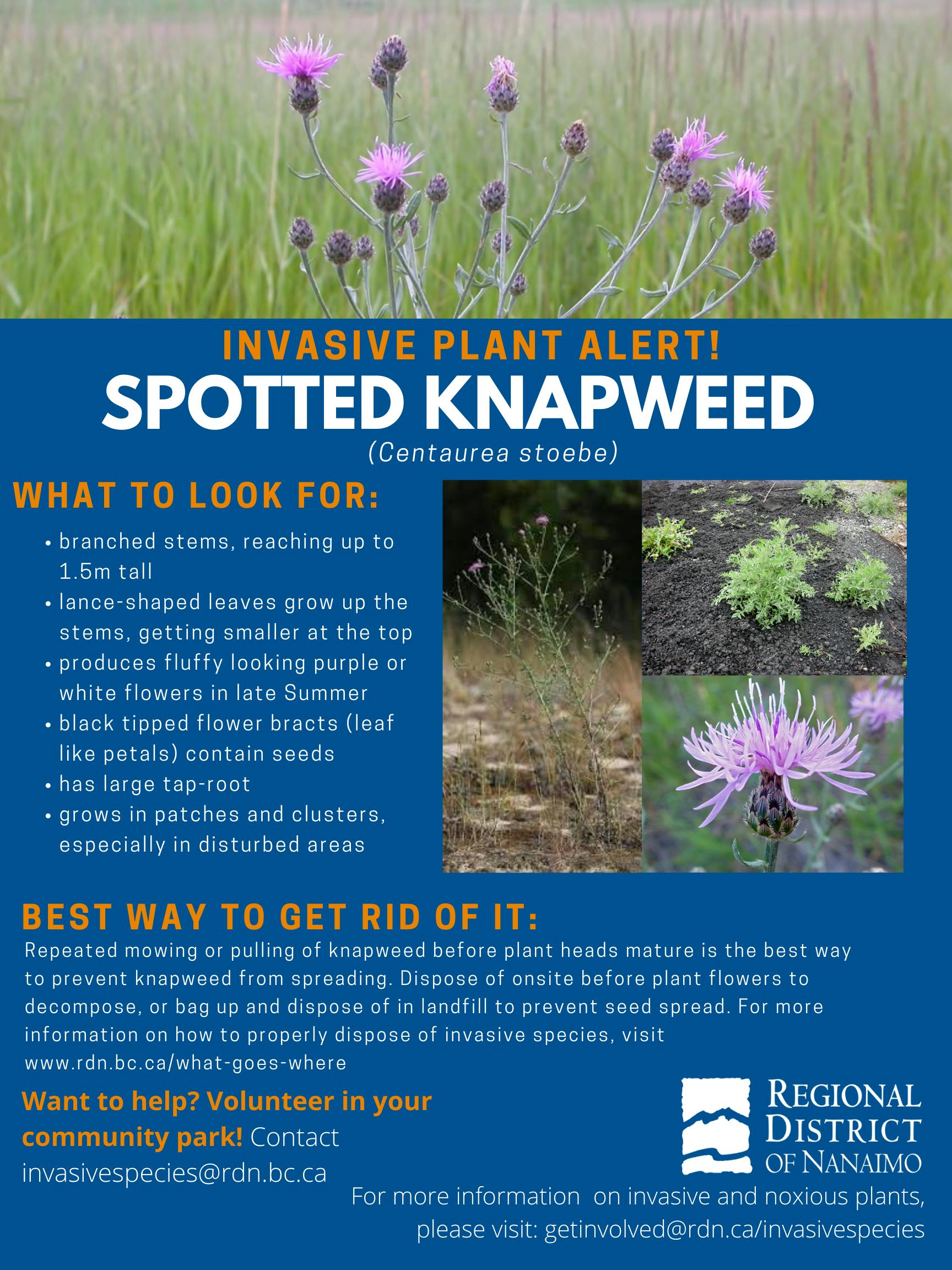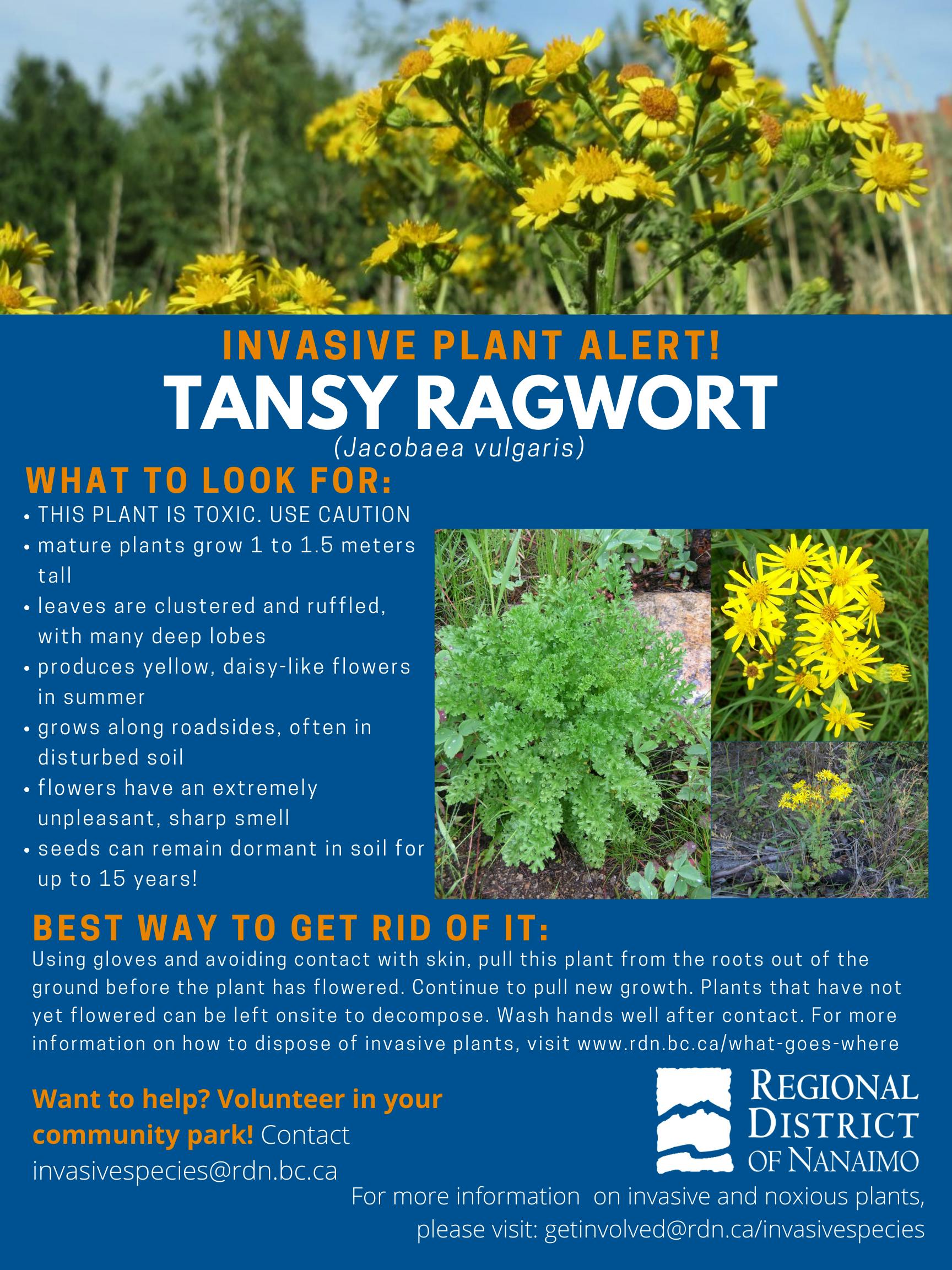Invasive Species in the RDN
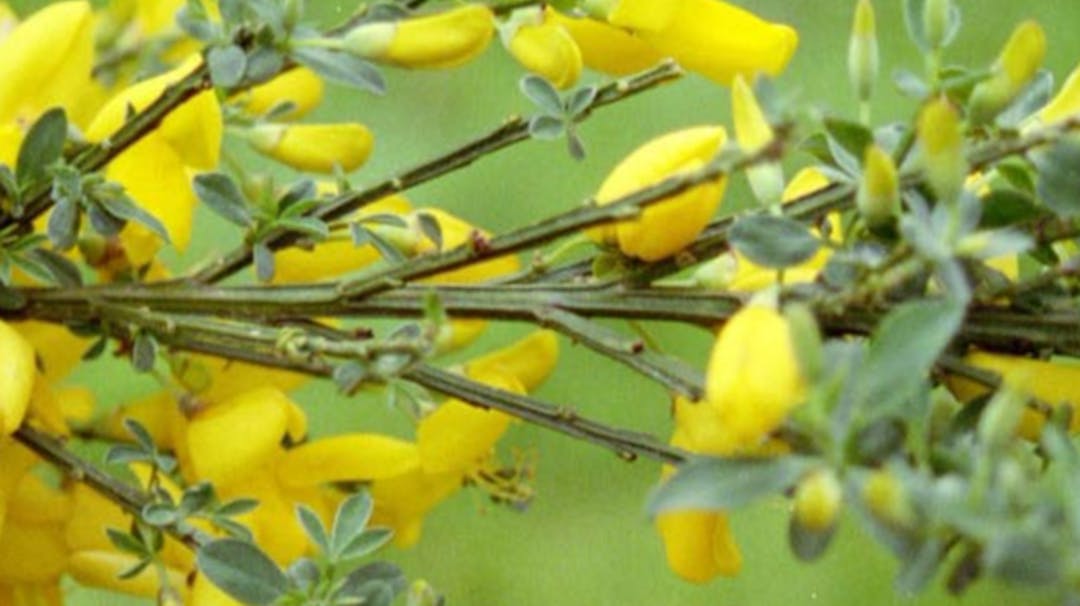
WHAT'S THE BIG DEAL WITH INVASIVE PLANTS?
Invasive plants like Scotch broom grow rapidly and are easily spread. Unfortunately these plants can cause a lot of problems like habitat degradation and destruction of biodiversity, damage to trails and park structures, and can even pose safety hazards to humans and pets if touched or ingested.
- Register with Get Involved RDN to provide input, ask a question, report an invasive, or to receive volunteer information!
- Check out our Invasive Species Gallery to see our top priority invasive species to manage!
- If you spot an invasive plant in an RDN park, please register and let us know by filling in the Report an Invasive tool.
- If you've found a plant in your yard, and aren't sure if it's invasive, or how to get rid of it, post your question in Ask a Plant Person, and we'll do our best to help you out!
- See our FAQ's, pamphlets, guides and helpful links to learn more!
WANT TO VOLUNTEER IN YOUR COMMUNITY PARK?
If you want to join in on the fun and help us with our battle against invasive plants, send an email to invasivespecies@rdn.bc.ca(External link) and you'll be added to our mailing list. You can also check out Volunteer Highlights below for updates on events, info for volunteers and new volunteer opportunities!
Please contact us before removing any plant from an RDN Park. It is against our bylaw to remove any vegetation from an RDN park without instruction from RDN Parks Staff.

WHAT'S THE BIG DEAL WITH INVASIVE PLANTS?
Invasive plants like Scotch broom grow rapidly and are easily spread. Unfortunately these plants can cause a lot of problems like habitat degradation and destruction of biodiversity, damage to trails and park structures, and can even pose safety hazards to humans and pets if touched or ingested.
- Register with Get Involved RDN to provide input, ask a question, report an invasive, or to receive volunteer information!
- Check out our Invasive Species Gallery to see our top priority invasive species to manage!
- If you spot an invasive plant in an RDN park, please register and let us know by filling in the Report an Invasive tool.
- If you've found a plant in your yard, and aren't sure if it's invasive, or how to get rid of it, post your question in Ask a Plant Person, and we'll do our best to help you out!
- See our FAQ's, pamphlets, guides and helpful links to learn more!
WANT TO VOLUNTEER IN YOUR COMMUNITY PARK?
If you want to join in on the fun and help us with our battle against invasive plants, send an email to invasivespecies@rdn.bc.ca(External link) and you'll be added to our mailing list. You can also check out Volunteer Highlights below for updates on events, info for volunteers and new volunteer opportunities!
Please contact us before removing any plant from an RDN Park. It is against our bylaw to remove any vegetation from an RDN park without instruction from RDN Parks Staff.

Invasive Advice
 Need help being sure if a plant is on our invasive species list? Not quite sure the best way to get rid of a plant? Drop your questions here. We'll do our best to help you find a solution!
Need help being sure if a plant is on our invasive species list? Not quite sure the best way to get rid of a plant? Drop your questions here. We'll do our best to help you find a solution!
-
Share I have recently moved into my house and this spring I'm noticing an explosion of Goutweed. It is extremely invasive and difficult to get rid of. I'm wondering why it isn't on the list of invasive species for the RDN? on Facebook Share I have recently moved into my house and this spring I'm noticing an explosion of Goutweed. It is extremely invasive and difficult to get rid of. I'm wondering why it isn't on the list of invasive species for the RDN? on Twitter Share I have recently moved into my house and this spring I'm noticing an explosion of Goutweed. It is extremely invasive and difficult to get rid of. I'm wondering why it isn't on the list of invasive species for the RDN? on Linkedin Email I have recently moved into my house and this spring I'm noticing an explosion of Goutweed. It is extremely invasive and difficult to get rid of. I'm wondering why it isn't on the list of invasive species for the RDN? link
I have recently moved into my house and this spring I'm noticing an explosion of Goutweed. It is extremely invasive and difficult to get rid of. I'm wondering why it isn't on the list of invasive species for the RDN?
Karla asked 11 months agoHi There Kayla,
Goutweed is a nasty invasive, we agree. We're working on updating some of our materials on invasive species in our region. For now, have a look at the resource below on how to take care of Goutweed infestations on your property!
-
Share How do you dispose of English Ivy after removal? on Facebook Share How do you dispose of English Ivy after removal? on Twitter Share How do you dispose of English Ivy after removal? on Linkedin Email How do you dispose of English Ivy after removal? link
How do you dispose of English Ivy after removal?
Roberta Bryan asked about 1 year agoEnglish Ivy is extremely good at sprouting from the smallest fragment left behind. The best way to dispose of English Ivy is to either pack it into your green bin, where it will be destroyed through high heat composting, or to bag it up and take it away to the landfill labeled as "Invasive Species". Whatever you do - don't put that Ivy in your home compost - it will take root and spread like the weed it is!
-
Share I have just moved to the area and have a lot of creeping buttercup taking over our lawn and I'm wondering if there are any effective ways of getting rid of it. I have also noticing it in some wilderness areas. If I was to pull it manually in our lawn I would be there forever! on Facebook Share I have just moved to the area and have a lot of creeping buttercup taking over our lawn and I'm wondering if there are any effective ways of getting rid of it. I have also noticing it in some wilderness areas. If I was to pull it manually in our lawn I would be there forever! on Twitter Share I have just moved to the area and have a lot of creeping buttercup taking over our lawn and I'm wondering if there are any effective ways of getting rid of it. I have also noticing it in some wilderness areas. If I was to pull it manually in our lawn I would be there forever! on Linkedin Email I have just moved to the area and have a lot of creeping buttercup taking over our lawn and I'm wondering if there are any effective ways of getting rid of it. I have also noticing it in some wilderness areas. If I was to pull it manually in our lawn I would be there forever! link
I have just moved to the area and have a lot of creeping buttercup taking over our lawn and I'm wondering if there are any effective ways of getting rid of it. I have also noticing it in some wilderness areas. If I was to pull it manually in our lawn I would be there forever!
Karla asked over 1 year agoCreeping buttercup is a pretty nefarious weed that is a bit of a challenge to get rid of. For small areas, repeatedly digging out the whole plant and any extra root systems is the best option. Because this plant can reproduce vegetatively, mowing or just cutting it can be counterproductive, and new sprouts can form from cuttings. Some people have had success with a natural weed killer, made from water, white vinegar, salt and a few drops of dish soap, and sprayed over the plant on warm sunny days. With larger areas infested with buttercup, I recommend a "cover and mulch" method. Cover the infected area with landscaping fabric or non-glossy cardboard, then pile on mulch, clean soil or wood chips at least 10cm thick over top. Over time, the plants and root systems will die, and you can re-seed the fresh soil overtop. What's most important is to prevent the spread of this plant, so any cuttings should be disposed of in your green bin, or bagged up and taken to the landfill for proper disposal.
-
Share Hello, We have an acre of forested land on our newly acquired property which has had years of unchecked invasion of honeysuckle vines! We have removed the old, thick vines which were strangling the trees - young arbutus suffer terribly - but new growth keeps coming. How can we stop it? Should we just pull up all the new shoots as we find them? They are everywhere...it's really hard to keep up! Thanks! on Facebook Share Hello, We have an acre of forested land on our newly acquired property which has had years of unchecked invasion of honeysuckle vines! We have removed the old, thick vines which were strangling the trees - young arbutus suffer terribly - but new growth keeps coming. How can we stop it? Should we just pull up all the new shoots as we find them? They are everywhere...it's really hard to keep up! Thanks! on Twitter Share Hello, We have an acre of forested land on our newly acquired property which has had years of unchecked invasion of honeysuckle vines! We have removed the old, thick vines which were strangling the trees - young arbutus suffer terribly - but new growth keeps coming. How can we stop it? Should we just pull up all the new shoots as we find them? They are everywhere...it's really hard to keep up! Thanks! on Linkedin Email Hello, We have an acre of forested land on our newly acquired property which has had years of unchecked invasion of honeysuckle vines! We have removed the old, thick vines which were strangling the trees - young arbutus suffer terribly - but new growth keeps coming. How can we stop it? Should we just pull up all the new shoots as we find them? They are everywhere...it's really hard to keep up! Thanks! link
Hello, We have an acre of forested land on our newly acquired property which has had years of unchecked invasion of honeysuckle vines! We have removed the old, thick vines which were strangling the trees - young arbutus suffer terribly - but new growth keeps coming. How can we stop it? Should we just pull up all the new shoots as we find them? They are everywhere...it's really hard to keep up! Thanks!
sonjas62 asked over 1 year agoThanks for your question! Believe it or not, Western Honeysuckle (Lonicera ciliosa) is a BC Native, however it's understandable that it can be a nuisance and exhibit invasive tendencies like strangling young trees.
The best way to remove these plants is to put in a lot of elbow grease! Continuously pull them out, and where possible, follow any root systems and dig out their source. If you're keen to prevent new sprouts from growing, you can place cardboard (as long as it's not glossy) on the ground where they are sprouting, and cover the cardboard with mulch. The cardboard acts as a weed barrier, and eventually will degrade and become part of the soil. The mulch will help keep the soil moist, as well as serving as a medium for new, more desirable plants to grow.
Check out the ISCBC website on Western Honeysuckle : https://bcinvasives.ca/play-your-part/plantwise/grow-me-instead/western-honeysuckle/(External link)
Let us know how you get on with your project!
-
Share We have tried over the years to return our little forest to only native species and have now essentially irradicated the Scotch broom and Daphne. Should we also attempt to remove the non-native Hawthorn trees which are also known to outcompete other vegetation and alter native ecosystems? on Facebook Share We have tried over the years to return our little forest to only native species and have now essentially irradicated the Scotch broom and Daphne. Should we also attempt to remove the non-native Hawthorn trees which are also known to outcompete other vegetation and alter native ecosystems? on Twitter Share We have tried over the years to return our little forest to only native species and have now essentially irradicated the Scotch broom and Daphne. Should we also attempt to remove the non-native Hawthorn trees which are also known to outcompete other vegetation and alter native ecosystems? on Linkedin Email We have tried over the years to return our little forest to only native species and have now essentially irradicated the Scotch broom and Daphne. Should we also attempt to remove the non-native Hawthorn trees which are also known to outcompete other vegetation and alter native ecosystems? link
We have tried over the years to return our little forest to only native species and have now essentially irradicated the Scotch broom and Daphne. Should we also attempt to remove the non-native Hawthorn trees which are also known to outcompete other vegetation and alter native ecosystems?
MarilynM asked about 2 years agoAmazing job battling those broom and Daphne!
Common hawthorn (Crataegus monogyna) is an introduced and invasive plant that is often found in our region, and is easily spread by birds eating the haws or fruits, and by small suckering plants. If you have the means to do so, absolutely start working on eradicating Hawthorne on your property. Check out the website below for more information on how to manage hawthorn: https://kingcounty.gov/services/environment/animals-and-plants/noxious-weeds/weed-identification/common-hawthorn.aspx(External link)
You may want to consider replacing the English hawthorn with other native plants - try Pacific crabapple (Malus fusca), Osoberry (Omleria cerasiformis), red osier dogwood (Cornus sericea), or Pacific ninebark (Physocarpus capitatus)
-
Share There are various BC companies that sell "locally sourced" products such as wildflower mixes, mushroom kits, grass seed etc. Instructions indicate that they are safe for use in our yards. How can BC consumers be confident that these products are free from potentially harmful invasive species? on Facebook Share There are various BC companies that sell "locally sourced" products such as wildflower mixes, mushroom kits, grass seed etc. Instructions indicate that they are safe for use in our yards. How can BC consumers be confident that these products are free from potentially harmful invasive species? on Twitter Share There are various BC companies that sell "locally sourced" products such as wildflower mixes, mushroom kits, grass seed etc. Instructions indicate that they are safe for use in our yards. How can BC consumers be confident that these products are free from potentially harmful invasive species? on Linkedin Email There are various BC companies that sell "locally sourced" products such as wildflower mixes, mushroom kits, grass seed etc. Instructions indicate that they are safe for use in our yards. How can BC consumers be confident that these products are free from potentially harmful invasive species? link
There are various BC companies that sell "locally sourced" products such as wildflower mixes, mushroom kits, grass seed etc. Instructions indicate that they are safe for use in our yards. How can BC consumers be confident that these products are free from potentially harmful invasive species?
The Grabs asked almost 2 years agoThat's a GREAT question!
While we can't recommend specific products, there are some tips we can share about how to make sure you're doing your due-diligence when buying seed mixes and "grow your own...." kits.
1. Check the ingredients - only buy seed mixes that list the plant species contained within. That way you can check to see if there are any invasive that may be problematic in your garden. Check out the BC Provincial Priority Invasive Species Link(External link) to find a list of invasive species in BC that might make their way into your seed mix.
2. Buy reputable certified grass seed - Seed certification shows that a seed mix has been evaluated to determine the probability of undesirable seeds making it into your mix. Check the label for the amount of "Weed Seed" or "Noxious Weed" and pick the lowest values you can find. Once your grass has germinated or started growing, be vigilant in removing weeds or grass varieties that are not desirable. Check out this article by the Invasive Species Council of BC on Seed Mixtures(External link)
3. "Grow your own" kits - These kits are becoming a popular way to grow food in small spaces, however there is not a lot known about how their contents might spread invasive plants. It's best to grow these in the container they arrived in, and best to dispose of any spent growing medium in your garbage.
When in doubt, pick local sources for these items, and ask lots of questions! It's also always safer to grow in containers if there's risk of invasives. Last but not least, give us a shout here, or by emailing invasivespecies@rdn.bc.ca(External link) any time with questions!
-
Share we have a patch of gorse in our pasture and it's spreading. How do we get rid of it? on Facebook Share we have a patch of gorse in our pasture and it's spreading. How do we get rid of it? on Twitter Share we have a patch of gorse in our pasture and it's spreading. How do we get rid of it? on Linkedin Email we have a patch of gorse in our pasture and it's spreading. How do we get rid of it? link
we have a patch of gorse in our pasture and it's spreading. How do we get rid of it?
Gayle asked almost 2 years agoThanks for the question! Gorse reproduces two ways - by seed, and by re-growing from stumps and other plant parts. This makes it trickier to get rid of than Scotch broom, but with a little dedication it's possible to get rid of.
1. Start by pulling out smaller plants, roots and all. Best to do this when the soil is soft and moist.
2. Cut larger pieces of gorse as close to the ground as possible. If you can dig up the roots, that's even better. Do this during or shortly after the plants have flowered.
3. If the infestation is not manageable by hand, you can take to mowing the area. Mow repeatedly and often. After several seasons, energy in the underground part of the plants will deplete and eventually die.
Don't forget to dispose of gorse properly. When appropriate, gorse can be burned (be sure to check fire bans and rules in your area). If burning is not an option, gorse should be bagged up in plastic bags and taken to the landfill for controlled disposal. Make sure to let them know you have an invasive plant that you're getting rid of.
Good luck, and thank-you for doing your part to tackle invasive plants!
-
Share Hi there, I have a giant hogweed growing in a riparian area on my property. Is this something that a professional should remove? I've heard they can cause burns and blindness! Thanks, Shea on Facebook Share Hi there, I have a giant hogweed growing in a riparian area on my property. Is this something that a professional should remove? I've heard they can cause burns and blindness! Thanks, Shea on Twitter Share Hi there, I have a giant hogweed growing in a riparian area on my property. Is this something that a professional should remove? I've heard they can cause burns and blindness! Thanks, Shea on Linkedin Email Hi there, I have a giant hogweed growing in a riparian area on my property. Is this something that a professional should remove? I've heard they can cause burns and blindness! Thanks, Shea link
Hi there, I have a giant hogweed growing in a riparian area on my property. Is this something that a professional should remove? I've heard they can cause burns and blindness! Thanks, Shea
sc asked almost 2 years agoGiant Hogweed (Herecleum mantegazzianum) is a dangerous plant with UV toxic sap contained in its stem and leaves, causing potentially severe rashes and burns.
We recommend that residents hire a professional gardener or landscaper handle the removal of this plant on private properties. The Coastal Invasive Species Committee(External link) may be able to help you find an appropriate contractor for this job.
While not recommended, should you choose to try and remove this plant yourself, follow the best practices for removal from the Invasive Species Council of BC (click here)(External link) , and ensure you take the following precautions:
- Wear waterproof long-sleeved coveralls or rain gear
- Protect eyes with safety glasses or goggles
- Wear long, waterproof gloves
- Avoid having any skin exposed
Should you accidently come into contact with Giant Hogweed sap:
- Wash the exposed area carefully with soap and water.
- Keep the area away from sunlight for at least 48 hours.
- Consult a doctor if a rash or blisters develop.
If you have any further questions, feel free to reply here or send an e-mail to invasivespecies@rdn.bc.ca(External link)
Follow Project
Upcoming Events
FAQ
- What is an invasive plant?
- How did invasive plants get here?
- How do I know if a plant in my garden is invasive?
- What about invasive animals and insects like bullfrogs and stinkbugs?
- What's the RDN doing right now to manage invasive plants?
- Am I in an RDN Park?
- How do I dispose of invasive plants properly?
- Does the RDN have any tools I can borrow?
Pamphlets and Guides
Who's Listening
-
Parks Operations Coordinator - Natural Areas


